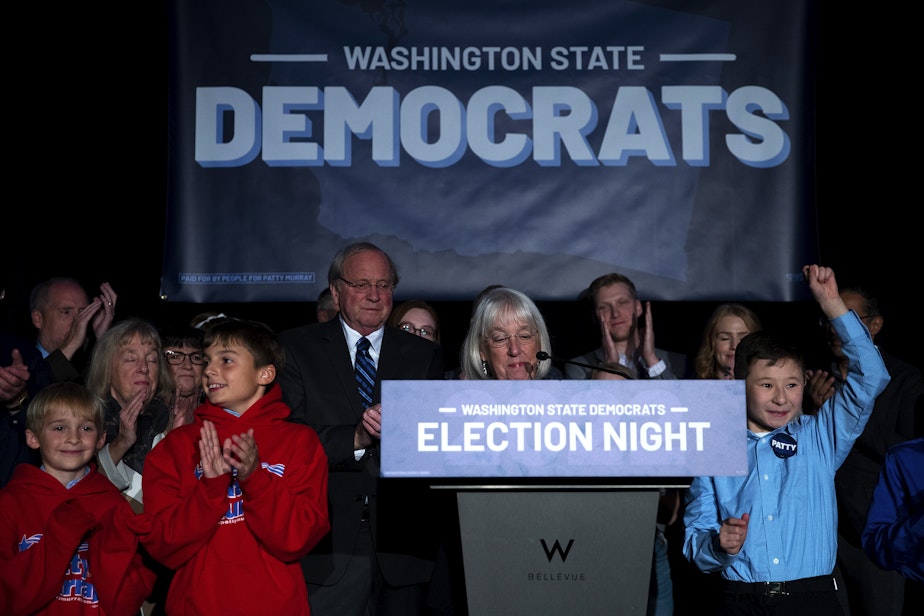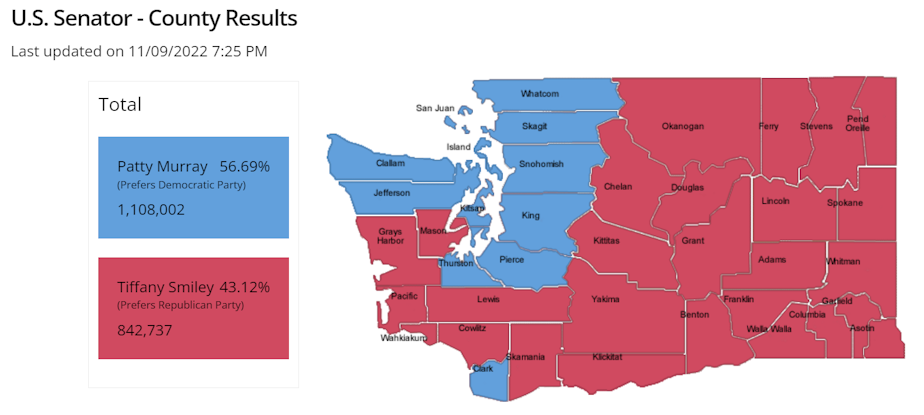WA polls got the Senate race wrong. What happened?

The outcomes from last week's midterms are still being finalized, but already some results stand in stark contrast to polling ahead of Election Day.
Stuart Elway, the director of the Crosscut/Elway Poll of Washington state voters, he spoke to KUOW's Angela King about the discrepancies.
This interview has been edited for clarity.
Angela King: Stuart, I want to start by asking about the Senate race between Democratic Senator Patty Murray, who won reelection, and Republican Tiffany Smiley.
We spoke to you just a few days before the election, and you’d said it looked like Smiley was actually closing the gap by quite a lot. Murray won by about 14 percentage points, though. So, what happened?
Stuart Elway: There were 19 polls on that Senate race after the primary, including 10 in the last month. Of those 19, 10 of them were conducted by Republican-affiliated organizations, including six of the last eight and all of the last three. The average of those Republican polls, over that whole period, was Murray plus three. [In other words, Murray led Smiley by just 3 percentage points.] The other polls conducted by media organizations and a couple of Democratic-leaning firms had the race at Murray plus 10, if you average it out. [Or, Murray led Smiley by 10 percentage points, according to those polls.]
So, I think they Republican-leaning polls skewed the polling averages that everybody looks at. That made it look like it was a lot closer. It turns out that was a mirage.
Sponsored
Tiffany Smiley ended up with the same vote percentage that Loren Culp got in the governor's race two years ago. Patty Murray got her average reelection vote plus two points.

So, do you have concerns with the methodology used in those Republican polls, or is this just a case of, "We got this one wrong"?
Well, the fact that there's such a difference between the Republican polls and the others indicates something's going on there. I'm not imagining that they're all sitting in a dark room someplace and making up numbers. They have to stay in business. They have to produce reliable numbers.
But polling comes down to who you ask and what you ask. The what you ask is: who are you planning to vote for? That's pretty straightforward. Who you ask is the sampling. Pollsters in the election have to figure out who the likely voters are, and then make sure they get a representative sample of those likely voters. So, you make sure you have enough young people, you have a balance of men and women, all of those things. But for likely voters, there's no census to compare it against; it's all educated guesswork.
Sponsored
I think a couple of things happened. One, it looks like young people turned out in much larger numbers than is typical, and they voted heavily Democratic, which would have blown up your likely voter model. The other thing is, you want to make sure you have the right number of Republicans, Democrats and Independents. In Washington state, where we don't register by party, there's nothing to anchor that to. So, you end up guesstimating how many Republicans are going to vote this time and how many Democrats. I think that these Republican-affiliated pollsters were overly optimistic in their guesstimate of how many Republicans were going to be voting. Then you couple that with Independents breaking pretty strongly for the Democrats, which is unusual in a incumbent race. [Take those factors together] and you get pretty far off. I think that's what happened.
You mentioned the younger electorate, so to speak. Do pollsters need to pay closer attention to young voters? Why have they been not paid as close attention to them?
They just don't vote. They haven't voted in proportion to the population. People over 65 make up less than 20% of the population, but they are over half of the perfect voters in Washington state. People under 35 are about 10% of the of the voters, but they are 18% of the population. This time, young voters came to the polls in numbers that they hadn't in previous elections. So, you base your likely voter model on previous elections, and you're going to miss that.
Well, one demographic we know you paid attention to, as well as other pollsters, was suburban women. When we first talked, according to your research, they seemed to be breaking for Tiffany Smiley. It doesn't look like that necessarily happened. But what effect did the group of suburban women ultimately have on Election Day?
Sponsored
I'm not sure. We don't have extensive exit polling from Washington. But looking at the national exit polls: The conventional wisdom was the economy was the number one issue, and that people were going to vote their pocketbooks. We thought that was the end of the story. Well, it wasn't the end of the story.
The economy was the number one issue in the exit polls. But it was only at 31%. Abortion was right behind it at 27%. Everything else was less than 10%. The Associated Press did another poll with 94,000 people across the country, and they asked people: what issue is going to determine your vote? The future of democracy got to 44%. So, when people got to the polls, they're thinking about abortion and the future of democracy. I think that was a large part of the swing vote. And those suburban women we keep talking about always made up a large section of the swing vote.
I know it's early; we haven't even gotten to Thanksgiving, let alone Christmas. Still, let's talk about 2024. Is there anything you can take away from the results that you're seeing now, when it comes to how you may conduct your research as a pollster?
In some sense, it's easier because it'll be a presidential year, and turnout will be greater. Our turnout [this year] was less than the last off-year election. Turnout in Washington is usually around 70% in these off-year elections, and it's up to 80-85% for the presidential years. So, finding those likely voters is less of a trick.
Sponsored
Republicans were disappointed across the board this time around. They lost Washington's 3rd Congressional District. They didn't pick up any seats in the state Legislature, and they expected to pick up quite a few. So, I think going into 2024, we'll be starting with the assumption that Washington is still a pretty blue state.





